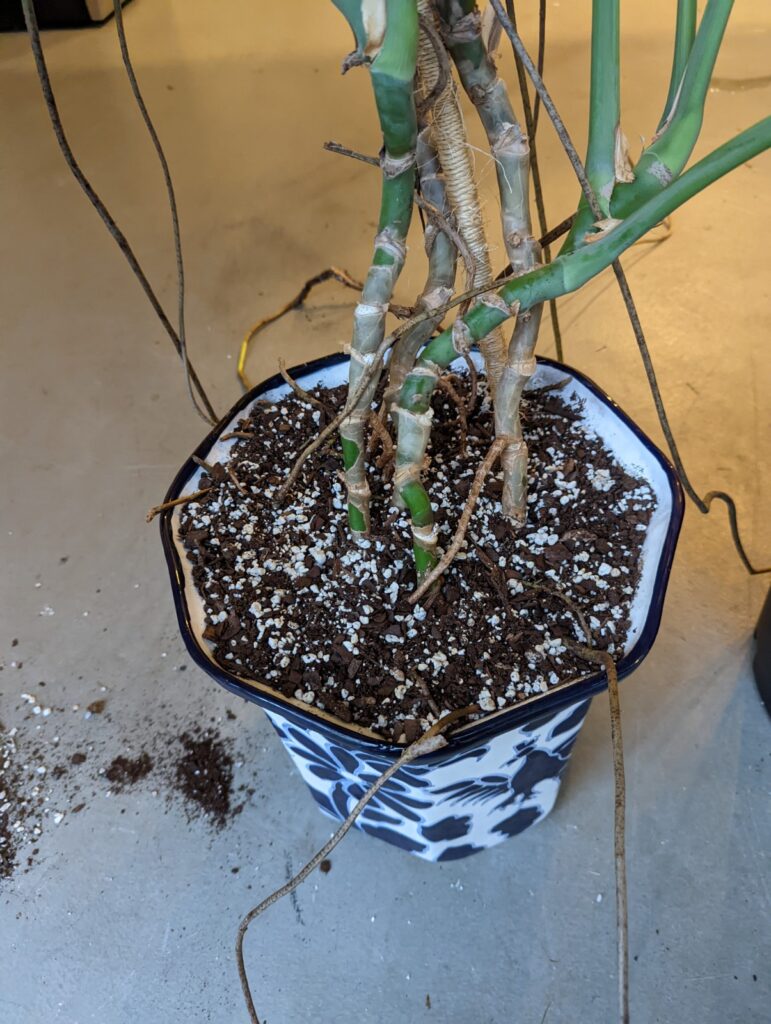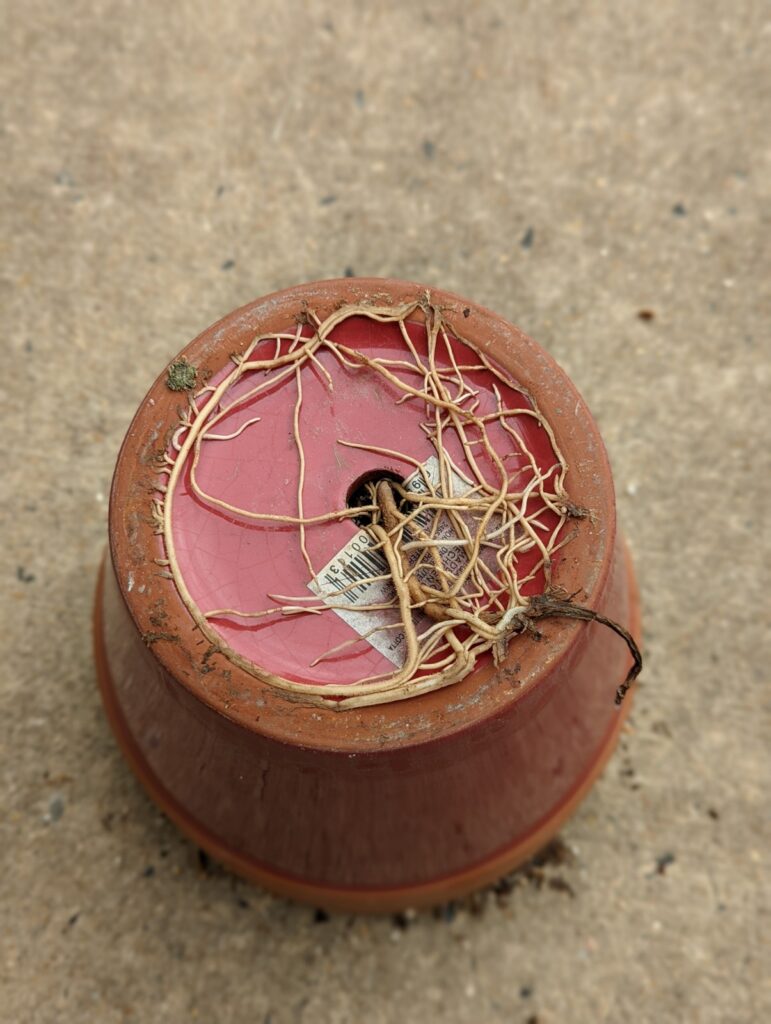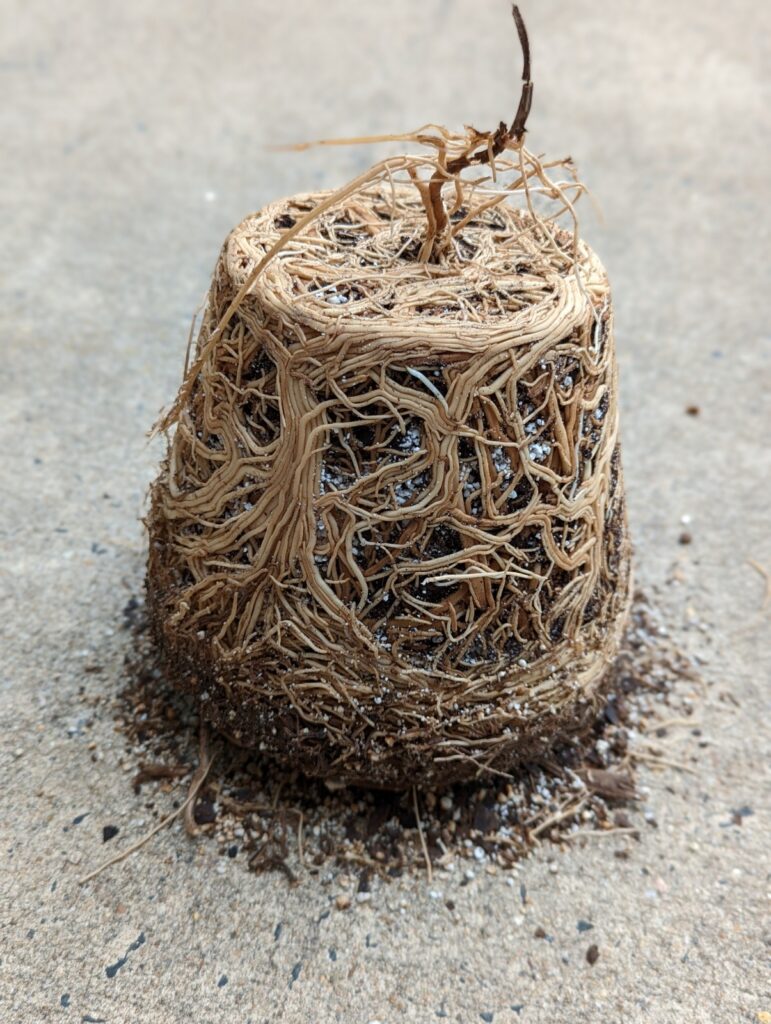Rootbound Monstera
I see a lot of people on plant forums asking if they have a rootbound Monstera. People also like to ask if Monsteras like to be rootbound. So in this post, I'm going to cover some tips on telling whether your Monstera is rootbound and I'll also tell you why it's not a great idea to allow your Monstera to stay rootbound.
Signs That You Have a Rootbound Monstera
Roots Coming Out of the Top of the Soil
One sign that your Monstera is rootbound is that its roots may start coming up out of the soil. If your Monstera's roots are reaching up and out of the pot, then there is most likely no room left to grow inside the pot. I'm not talking about aerial roots either. Aerial roots are a totally different thing, they start growing outside of the soil and then grab onto things (sometimes soil) to help support the Monstera as it grows. See the picture below for an example. There are roots growing out in the top left corner and also the front of the pot, but there are also aerial roots.

Roots Growing Out of the Bottom of the Pot
This is really the same concept as above. In fact, I think it's more common for Monstera roots to grow out of the bottom of the pot's drainage hole than it is for the roots to grow up and out. I think it's because the roots are following the water and the water flows down due to gravity (just my theory). It's too bad this is more common because it's harder to spot this unless you're lifting the pot frequently. Let's be honest, lifting the pot frequently probably isn't happening, but if you're questioning if your plant is rootbound that's one way to check. See the picture below for an example.

Monstera is Too Moist or Too Dry
Your Monstera could be rootbound and show no visible signs like the ones I've explained above. It could be that your Monstera's soil is drying out too fast, or it's drying out too slowly. Either of these could be a sign that you have a rootbound Monstera. If it's drying out too fast it could be that the roots have displaced so much soil that there's not much left. Soil holds moisture, so with less soil, there's less potential to hold moisture. Conversely, the roots could have grown so much that they are blocking water from draining out of the bottom of your pot. In this case, the soil is not able to dry out well enough. You should be able to lift your Monstera out of the pot a little bit to check if it's rootbound. If it's extremely difficult to lift your Monstera out of the pot, then it's probably rootbound and the roots are clinging to the side of the pot making it difficult to move.
Do Monsteras Like to Be Rootbound
No. In fact, I don't think any plants like to be rootbound. I've heard of people recommending it for certain plants to make them bloom, but you're really just creating a stress response in that case. I digress. Monsteras do not like to be rootbound for the same reasons I already outlined in the last section. A pot with overcrowded roots is bound to have soil moisture issues eventually and that is not good for your plant. In addition, your Monstera will grow much more slowly if it's rootbound.
How to Fix a Rootbound Monstera
Removing a Rootbound Monstera From a Pot
The hardest part is getting the rootbound Monstera out of the old pot. Monstera roots are extremely aggressive and grippy. Once the roots have grown up against the inside wall of the pot they grab on with all their strength. Needless to say, getting the rootbound Monstera out of the pot is going to be the hardest part. But, I have a secret weapon for you, dear blog reader. Use a long icing spatula to wedge in between the pot and the soil/roots and then muscle it around the entire inside perimeter of the pot like you're cutting brownies away from the side of the pan. They make really long ones too. The bigger your pot the longer you'll need.
Even with this tip, in my experience, you'll still need some sweat and some curse words to finally get it free. You'll want to try and rock the plant to loosen it from the pot. The roots will be stuck to the bottom of the pot too and there's really no good way to loosen those roots. It's good to hold the Monstera by the stem as close to the soil as possible while doing any rocking. I've even gone as far as sticking a pole into the drainage hole to try and push the rootball out of the pot.
Loosen the Root Ball

Once you have removed the rootbound Monstera, you may have a tight root mess such as the one I have pictured above. This needs to be loosened up or you may still end up with soil moisture issues. There's no good way to do it. You want to try to be gentle, but we already know that Monstera roots are super strong and grippy. Try to free some of the roots that are clearly circling the old pot so that they can grow outward in the new pot.
Repotting a Rootbound Monstera
To repot, there's nothing particularly special that you need to do. The main guidance is to get a pot that is two inches (in diameter) larger than your old pot. You also want to make sure the pot has adequate drainage. And finally, my pro tip is to select a pot that is glazed on the inside or plastic, because the roots will not stick to that as much as other mediums such as terracotta. If you're looking for more info on repotting, follow my previous post on Monstera repotting.
Have you battled a rootbound Monstera to get it out of its old pot? Share your war stories in the Comments.
Add new comment